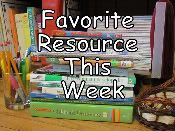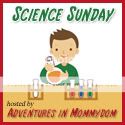I love this time of year, don't you? Planning for the upcoming academic year is always so exciting! Especially when my kids are asking me "What do we get to learn about next, Mom?" It's wonderful to see their enthusiasm (and I'll probably need to remind myself of this moment around February of next year!)
Choosing curriculum can be fun, but it can also be overwhelming. There is so much out there, and what works great for one family isn't necessarily the best choice for another.
Over the years we've tried lots of materials and methods. Every year I feel a little more confident in choosing what will work for me and my kids. And every year I make at least one wrong turn! I guess it comes with the territory.
Science and History
We're making a change in our routine this year. Instead of devoting an afternoon to science and an afternoon to history each week, we're incorporating science and history into monthly unit studies. In the past we did NOEO Science and Dad taught history, using SOTW as an outline. But we tend to get really into whatever we're doing at the time, and going back and forth between science projects and in-depth history studies was too much for all of us.
I've noticed that lots of homeschooling families alternate between science and history. I'm hoping it will make it easier to really focus on whatever we're doing at the time. I'm sure it will make it easier for me to have the right materials on hand, as well!
 Elephant books for our unit study
Elephant books for our unit studyOur first two unit studies (Elephants and Be a Scientist!) are homemade. I put them together from lots of different sources, including books we already had, library books, art projects I found online and other web resources. If I ever get around to it, I'll organize them and post a link to share.
Our other unit studies for the year are based on Teacher Created Resources
Immigration, History Pockets
Ancient Greece and
Ancient Rome, Intellego
Economics, Windows on the Wild
Oceans of Life, GEMS
Plate Tectonics, and The Mailbox's
Human Body. I say "based on" because we never use a ready-made unit study without supplementing and customizing. Not sure if that means I'm creative, or just a control-freak!
My favorite science resources:
Anything by Janice Van Cleave
Anything by Ellen McHenry
GEMS
DK Books
The Way Things Work and
The Way We Work by David MacAuley
And history resources:
Horrible Histories by Terry Deary
History PocketsYou Wouldn't Want to Be Series
Spend a Day Series by Ellen Honan
Language Arts
My kids would do science and history all day, every day if I let them. But into every education a little grammar must fall...
After a lot of thought, I made the decision to use textbooks for grammar and language arts this year. This may not seem like a big deal, but it was for me, because I've tried so hard to avoid any and all textbooks since we started homeschooling. I still have unpleasant memories of the boring "read-the-textbook, do the questions" model from my own school days. Charlotte Mason didn't like them, and generally, neither do I!
In the past, we've used Susan Van Zile's
Awesome Hands-on Activities for Teaching Grammar,
101 Ways to Love a Book from Teacher Created Resources,
Fill-in Flip Books for Grammar, Vocabulary, and More by Michael Gravois, and
Grammar Games and Activities that Boost Writing Skills by Immacula A. Rhodes.
I still think those are great resources and I'm sure we'll continue to use them! And we will definitely use the
Four-Square system for all our writing projects (Judith S. Gould and Evan Jay Gould.) But...I need at least one core subject to be easy and already mapped out for me. Especially since 6th grade and 4th grade language arts are so different. I just can't create a custom curriculum for everything!
 From Voyages in English 4
From Voyages in English 4 As far as textbooks go,
Voyages in English by Loyola Press doesn't look too bad. The graphics are fun without being babyish or distracting. And most importantly, the explanations are really clear. The first few lessons are a total review of what we did last year, and the kids are going to complain about that, but I think a little review never hurt anyone.
 Evan-Moor's Spell and Write pages
Evan-Moor's Spell and Write pagesI'm also taking a slightly easier route for spelling this year. We've used
AVKO Sequential Spelling before, and it's a great system. But, once again, I needed something that the kids could do independently. I looked at a lot of spelling workbooks in a teacher supply store and eventually chose Evan-Moor's
Spell and Write. I liked these because they begin with an interesting reading passage that uses the words in context. Then you practice writing the words a variety of ways. Each chapter ends with a test. However, there are no review pages or tests, so I'll have to make those on my own.
I'm looking forward to adding more poetry to the mix this year. In fact, I think we'll start each day with poetry (we used to do math first every day, but I'm thinking the kids will like reading and discussing a poem before diving into our day.) There are so many good poetry resources out there. Teacher FileBox has reproducibles for grade levels up to 6th, but mostly, we'll just use the poetry books that we already have.

Dude fell in love with concrete poetry after reading
technically, IT'S NOT MY FAULT by John Grandits, and he's been creating his own ever since. Both kids love
Behold the Bold Umbrellaphant by Jack Prelutsky (amazing illustrations by Carin Berger.) In fact, pretty much anything by Jack Prelutsky is fun to read and easy to memorize, if you're into reciting poetry. And Shel Silverstein, of course! We have
A Light in the Attic, Where the Sidewalk Ends, and Falling Up. Oh, and an easy cure for a kid in a bad mood: make them read
Runny Babbit aloud. Works every time!
Math
 Math faves (minus Primary Challenge Math--I miss you, Buddy!)
Math faves (minus Primary Challenge Math--I miss you, Buddy!) Math! My favorite! ( And I never thought I would say that!) Math is where we get really creative. I try to make it as hands-on as possible. We follow the scope and sequence from the
Core Knowledge series. The kids move at their own pace, and I absolutely do not rush them through anything for the sake of "keeping up" with a predetermined schedule. When it comes to math skills, we're aiming for mastery and real understanding, not "covering" lots of material.
So, using the
Core Knowledge series as my guide, I put together a very flexible plan with weekly and monthly goals for each kid. Then I found games and activities to match each concept. My favorite resources for this are:
Family Math by Jean Kerr Stenmark, Virginia Thompson, Ruth Cossey and Marilyn Hill
Math Wise by Jim Overholt and Laurie Kinchloe,
Independent Practice series from The Mailbox
Pretty much anything by Marilyn Burns!
Games: Mythmatical Battles, Roll-n-Multiply, Multiplication and Division Bingo, Monopoly, Logic Links, etc. A homeschooling buddy was selling outgrown sets of 'Smath and Exact Change, so we'll try those soon.
 Our "official" math games (but don't most games teach math?)
Our "official" math games (but don't most games teach math?)
Much to my frustration and sorrow, I
lost my copy of
Primary Challenge Math by Edward Zaccaro. If I find it, we'll use the challenges for collaborative problem-solving exercises. We'll put one of the challenges on the white board and brainstorm together. (Can you tell I've been reading Alfie Kohn this summer?) If I can't find it, I also have a good book called
Math Stories for Problem Solving Success by Jim Overholt, Nancy Aberg, and Jim Lindsey.
As allergic as we are to worksheets, there does come a time when kids just need to practice a new concept or refresh an old one. That's where Evan-Moor's Teacher FileBox comes in. Math Mammoth also has good practice pages. And if we're moving along at a pretty good pace, I told the kids we could start reading
Life of Fred by Stanley Schmidt on Fridays. I love how they are excited about doing something that is (secretly) good for them!
German
 German resources
German resourcesWe'll continue our German studies using
German in 10 Minutes a Day, by Kristine K. Kershul (thanks to Michelle at
Urban Cottage Homeschool for the recommendation!) We also have a great DK visual dictionary and
Let's Learn German by Marlene Goodman. The labels that I put on everything when our German friends were visiting are still up, and I'm planning to add some more. The kids are looking forward to writing letters to their German friends as well.
 A page from German in 10 minutes a day
A page from German in 10 minutes a day
Art and other fun stuff...My big purchases for the fall, besides
Voyages in English, are a pocket chart and stand, and Atelier art curriculum. The pocket chart will hold our calendar, spelling words, and cursive letters of the week, but I'm really going to use it as a room divider. The kids do 90% of their work together, but when they are working independently they need their own space. And if I let them wander off, they take forever just to decide where they are going to work, and then I have to keep checking on them, and I'm going from room to room answering questions... I'd rather have them stay in our school area, but give them their own space by dividing the room. We'll see how it works!
 I must be looking forward to school--I'm already making our August calendar!
I must be looking forward to school--I'm already making our August calendar!I'm excited about using Atelier for art this year. When I asked the kids for their planning input, they both said they wanted to do more art at home instead of taking art classes at our rec center. Homeschool Buyers Co-op has Atelier on sale at the moment, so I jumped on it! I have no idea what to expect, but it's art! How can it not be fun?
I'm not sure where art will fit into our routine, but I'm thinking we may just take an art day every couple of weeks or so. I'm also writing field trips into our monthly plans this year: the "do them as we have time" plan didn't work too well.
 Our cozy new reading area, with favorite blankets!
Our cozy new reading area, with favorite blankets!
We're looking forward to another fun year of homeschooling! I can't wait to check out the other links and see what you're doing! Have a great year!
This post is linked to
Heart of the Matter's Not Back to School Blog Hop! Join us at the hop!

This post is linked to the
2011-2012 Curriculum Special Edition at Weird, Unsocialized Homeschoolers! Check out the great links there!


































































